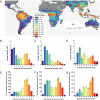Benchmark map of forest carbon stocks in tropical regions across three continents
- PMID: 21628575
- PMCID: PMC3116381
- DOI: 10.1073/pnas.1019576108
Benchmark map of forest carbon stocks in tropical regions across three continents
Abstract
Developing countries are required to produce robust estimates of forest carbon stocks for successful implementation of climate change mitigation policies related to reducing emissions from deforestation and degradation (REDD). Here we present a "benchmark" map of biomass carbon stocks over 2.5 billion ha of forests on three continents, encompassing all tropical forests, for the early 2000s, which will be invaluable for REDD assessments at both project and national scales. We mapped the total carbon stock in live biomass (above- and belowground), using a combination of data from 4,079 in situ inventory plots and satellite light detection and ranging (Lidar) samples of forest structure to estimate carbon storage, plus optical and microwave imagery (1-km resolution) to extrapolate over the landscape. The total biomass carbon stock of forests in the study region is estimated to be 247 Gt C, with 193 Gt C stored aboveground and 54 Gt C stored belowground in roots. Forests in Latin America, sub-Saharan Africa, and Southeast Asia accounted for 49%, 25%, and 26% of the total stock, respectively. By analyzing the errors propagated through the estimation process, uncertainty at the pixel level (100 ha) ranged from ± 6% to ± 53%, but was constrained at the typical project (10,000 ha) and national (>1,000,000 ha) scales at ca. ± 5% and ca. ± 1%, respectively. The benchmark map illustrates regional patterns and provides methodologically comparable estimates of carbon stocks for 75 developing countries where previous assessments were either poor or incomplete.
Conflict of interest statement
The authors declare no conflict of interest.
Figures




References
-
- Denman KL, et al. In: IPCC Climate Change 2007: The Physical Science Basis. Solomon S, et al., editors. Cambridge Univ Press; 2007. pp. 499–587.
-
- Schrope M. When money grows on trees. Nat Rep Climate Change. 2009;3:101–103.
-
- Van der Werf GR, et al. CO2 emissions from forest loss. Nat Geosci. 2009;2:737–738.
-
- Dixon RK, et al. Carbon pools and flux of global forest ecosystems. Science. 1994;263:185–190. - PubMed
Publication types
MeSH terms
Substances
LinkOut - more resources
Full Text Sources
Miscellaneous

